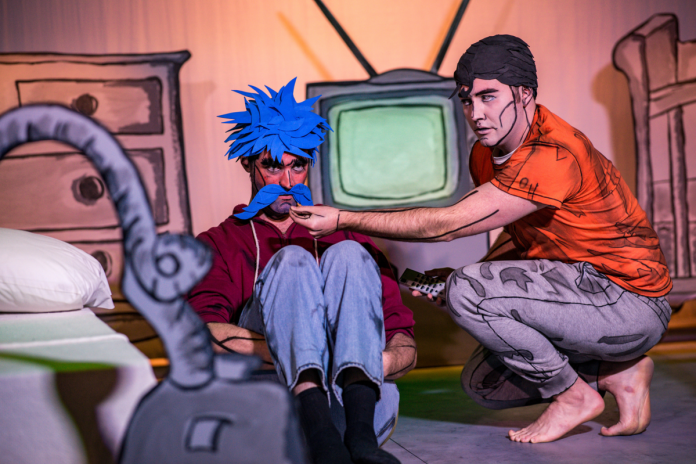Denise, a former drug addict and sex worker, and R.J., a TV addict and ex-con, hope they’ll get their baby back from foster care. Set in a dingy motel room, the two deal with Helen, a by-the-book government caseworker, and Phillie, the wino motel owner.
Written by George F. Walker, it’s distinctly a dark comedy, touching on serious and intense real-world problems of the underclass. It broaches the dubity of justice as seen by a struggling family, and in many ways, showcases the delicate intricacies of morality.
Raina von Waldenburg, UFV theatre instructor, is the director of Problem Child.
“It’s a gritty one-scene play. You know, one location, only gritty characters, gritty life,” von Waldenburg said. “The sad part is that these people in the play, these characters, are in a social stratum that they most likely can never get out of — they can’t escape that stratum.”
Steven Bowman, UFV student, plays Phillie, the motel owner.
“It’s such a heavy satire that you’re going to be thinking that it wasn’t funny, it’s heartbreaking,” Bowman said. “It’s like that on purpose, to ask a very hard question in a very palatable way. And that’s definitely what is unique about this play. Because it’s not a drama. It should play out as a drama. But it’s not a drama.”
UFV’s Problem Child exists in a graphic novel world. This governed set and prop design, costume and makeup, and actor choreography.
The play features exceptional makeup and costume design, envisioned and created by wardrobe manager Heather Robertson, who came up with the graphic novel idea. The makeup and costumes emphasize bold penciled outlines, and vibrant colour fills. The actors’ costume and makeup takes about one and a half to two hours to apply.
The set, designed by assistant professor Parjad Sharifi, aside from a few props, is in grayscale, which sharply contrasts the character’s bold colours. Lighting is also used to keep the illusion of flatness, along with saturated colours, characteristic of a graphic novel.
The play is specifically choreographed to portray a two-dimensional world. Actors are permitted to move around stage as if it were a grid of 90 degree angles and movements.
“The set is two dimensional, but of course we’re three dimensional, so we’re stuck doing lane work,” Bowman said. “It’s a practice and viewpoint where you can either go straight, backwards, left, or right. There’s no diagonal.
“There’s something really wild about hearing such profound content of human struggle coming out of a Playmobil face, cartoon fingers, and a foam wig. That’s so weird,” von Waldenburg said.
Problem Child has been a challenging project, with a significant amount of tightly timed sound and light cues, and complex choreography. Compounding the tension of the last week of rehearsals, Problem Child’s lead actress, citing personal reasons, dropped out less than two weeks ago. With no understudy, a replacement was quickly found, and thrust into the Problem Child world with under three weeks to learn months of rehearsals.
“It’s been a difficult process, for a lot of reasons,” von Waldenburg said. “I think it was really hard to force people into such a tight container. I kept saying to my actors, ‘It’s going to suck for a long time, and you might feel claustrophobic and constricted, but there’s going to come a moment after we’ve carved the fuck out of this little tight structure, I think you’ll start to have fun in there.’”
But what was an intense learning curve, Bowman said, became freeing, just as von Waldenburg predicted.
“As things progress, and you get used to the blocking and lines, you’re allowed to let your impulses kind of take you where the character wants you to, because you no longer have that block in front of your emotions,” Bowman said.
Problem Child has a runtime of about 80 minutes. Admission is “pay what you can” at the door, cash only. Suggested prices are $15.00 for adults, $10.00 for students and seniors.
Seats can be reserved by emailing theatre@ufv.ca with your name and number of seat reservations required, or by phone, (604) 795-2814. Seats are reserved until five minutes before show start time.
Image: UFV Flickr


